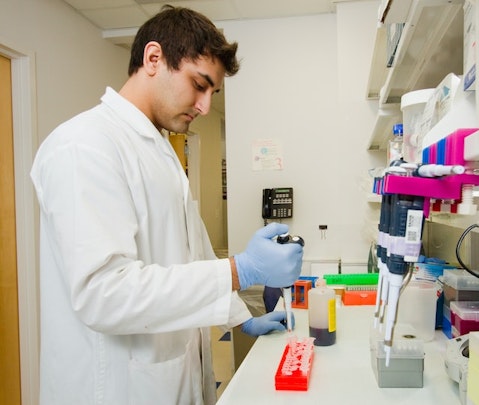argenx SE (NASDAQ:ARGX) Q4 2022 Earnings Call Transcript March 2, 2023
Operator: Good morning. My name is Rob, and I will be your conference operator today. At this time, I would like to welcome everyone to the call. All lines have been placed on mute to prevent any background noise. After the speakers’ remarks, there will be a question-and-answer session. Thank you. I’d like to introduce Beth DelGiacco, Vice President of Corporate Communications and Investor Relations. You may now begin your conference.
Beth DelGiacco: Thank you, operator. A press release was issued earlier today with our full year 2022 financial results and the recent business update. This can be found on our website along with the presentation for today’s webcast. Before we begin, I’d like to remind you on Slide 2 that forward-looking statements may be presented during this call. These may include statements about our future expectations, clinical developments, regulatory timelines, the potential success of our product candidates, financial projections, and upcoming milestones. Actual results may differ materially from those indicated by these statements. argenx is not under any obligation to update statements regarding the future or to conform those statements in relation to actual results unless required by law.
I’m joined on the call today by Tim Van Hauwermeiren, Chief Executive Officer; Karl Gubitz, Chief Financial Officer; and Keith Woods, Chief Operating Officer. I will now turn the call over to Tim.
Tim Van Hauwermeiren: Thank you, Beth, and welcome, everyone. Next slide. Reflecting on 2022, it was a year of many achievements for argenx as we evolved from an R&D organization into a fully integrated R&D and commercial organization. We launched our first in class FcRn blocker VYVGART in the U.S., Japan and Germany and exceeded our own expectations, generating $401 million in global net product revenue. I’m very proud of the team for the strategy they built and executed, solidifying our reputation with our key stakeholders. With this significant momentum, we start 2023 in a position of strength. We also have our marching orders in hand for multi-dimensional expansion to reach more patients with VYVGART through anticipated regulatory approvals and launches in new regions and by driving usage earlier in the gMG treatment paradigm.
Next slide. This year, we also generated a significant amount of data on our first in class FcRn blockers through clinical trial readout, installation research and pre reviewed publications. We reported 50 data from our subcu bridging study in gMG, which demonstrated non inferiority to the IV, based on IgG lowering, as well as consistency across secondary efficacy endpoints and safety. We have now filed for approval with the FDA, EMA and PMDA and have a PDUFA target action date in the U.S. of June 20, 2023. We received a communication from the FDA in January notifying a three month clock extension. Since that time, the FDA’s review continues and we are engaging regularly with the agency being responsive to inquiries as we advance towards an anticipated approval.
We reported 50 ITP data from our first registration trial last May and presented these data during a planned recession at ASH in December, which triggered significant interest from the hematology community. We are preparing to submit an MAA in Japan in the middle of this year for approval, based on the first advanced trial and will await the data readout of advanced subcu in the second half of this year to support filing in the U.S. and Europe. Across all of our efgartigimod studies, we also generated significant data in 2022 to broaden the scope of our safety database, which now includes more than 3,000 commercial patients globally, more than 1,300 clinical subjects, up to 19 cycles of intermittent cyclic dosing, and more than two years of weekly chronic dosing, all with a cumulative exposure of more than 1,000 patient years.
Lastly, before we look ahead to 2023, I want to call out a strong sign that continues to serve as a cornerstone of argenx, solidifying our leadership in FcRn as both the first in class and likely best in class therapy. Our teams are committed to building a deep repertoire of preclinical and translational data, which can serve as an important basis for indication selection or to underscore the clinical or commercial data we are generating. We had several key publications in 2022 including on, one, the long term remission fee observed in and the underlying reduction of autoreactive B-cells. Two, the differentiation of our Fc fragment and its intracellular phase keeping FcRn in its recycling path without interfering with albumin homeostasis. Three, review of the humeral immune response to vaccines during treatment.
And four, multiple publications and presentations on the health economic outcomes front highlighting the value that this drug can bring to gMG patients from a quality of life perspective. Next slide. We are well on our way to achieving the argenx 2025 vision, which we laid out a couple of years ago. Specifically, we are now reaching patients with VYVGART globally, evaluating efgartigimod in 13 severe autoimmune indications, preparing for the first clinical efficacy data from ARGX-117, our next pipeline in the product candidate and we are investing in our ecosystem of innovation. We have an impressive track record for molecules that have emerged from our immunology innovation program, both within our own pipeline and those with our partners.
Beyond efgartigimod and ARGX-117, some of these include, ARGX-119, an agonist to muscle specific kinase, we dosed the first subject last month, our third pipeline candidate is now clinical stage. Cusatuzumab targeting CD70, we formed Oncoverity with the University of Colorado last year based on the translation work of Dr. Clayton Smith on the CD27/CD70 pathway, which when combined with our clinical studies is a pretty robust data set. ARGX-112, targeting IL-22 receptor in development by LEO Pharma and moving forward in development. And ARGX-115, targeting GARP development by AbbVie, which is also advancing. Next slide. We have a very busy year ahead as this progress even further on our path as an integrated immunology company. We continue to expect top line data from the ADHERE trial of efgartigimod in CIDP in the second quarter of 2023.
There remains a significant unmet need for CIDP patients for a safe, effective therapy with a manageable dosing schedule and delivery. With ADHERE, we hope to address these needs and demonstrate the potential for efgartigimod to provide patients with a differentiated therapeutic profile across efficacy, safety and convenience measures. In addition to the advanced subcu readout, in the second half of this year we also expect pivotal data from the ADDRESS trial for pemphigus. With ADDRESS, we hope to see efficacy data, which build on the exciting results from Phase II, a fast onset of action driving patients into disease control and ultimately complete remission with the ability to taper to a minimal dose of steroids. We will have our first group of concept data in post COVID POTS in the fourth quarter of 2023.
This was an indication that was brought to us, particularly with the growing incident in the wake of COVID. Physicians report that IVIg and patients, and we know that anti adrenergic and antinuclear antibodies are involved in disease pathophysiology. All of this is a strong rationale for evaluating efgartigimod in what could be a very sizable indication. Finally, we’re also planning for the first clinical efficacy data from ARGX-117 in patients with multifocal motor neuropathy. IVIG is the only treatment option for MMN, and it comprises a significant proportion of that market. With our interim analysis in the middle of this year, we will have data from the first cohort of nine patients. Our data snapshot is to determine whether to advance to its second larger cohort and at which dose.
We continue to produce translational data supporting the pathological role of IgG autoantibodies in MMN and the rationale for a C2 inhibitor as a new treatment modality. Before I turn the call to Karl, I want to spend a few minutes on the leadership transition we announced today with its planned retirement. We are very excited to welcome Karen Massey to the team as our Chief Operating Officer as of March 13, 2023. She is a very talented and inspirational leader with significant operational and commercial experience. She’s joining us from Genentech Roche, where for the last three years she had a global clinical operations team of over 2,000 people. She has a broad commercial experience, including specific experience within the neuroinflammation space, having launched first in class medicines which disrupted the treatment paradigm.

Photo by National Cancer Institute on Unsplash
I was very impressed to hear about her role with Ocrevus launch, taking an already successful launch and accelerating it in a crowded market. Beyond this remarkable achievement, the quality that most caught my attention is to focus on building teams, creating a company culture and community and designing nimble, global, innovative organization, all of which will benefit argenx. I would also like to share with you my gratitude to Keith for his partnership and his friendship. He is a visionary leader with signs and to the patients at the center of everything we do. We are so fortunate for the role he has played in our growth over the last five plus years of his distinguished career in biopharma. He joined argenx after the release of data, when he convinced me that argenx could launch efgartigimod.
He saw a vision for argenx commercially not only in the U.S. but also Japan, Europe and Canada. I could never imagine at that time the impact it could have on patients, even in the first year of launch. He was committed throughout our search process to find the right person to fill his role. I knew I could count on him to stay until we all agreed we had the right successor and we are both very confident we have that in Karen. We are also fortunate he will be staying with the company not only during the transition period, through the SC Efgartigimod launch, but also after he retires. He will transition to serve as a Board adviser on our commercial committee, but he will continue to make a significant impact on our commercial strategy and for our patients.
And with that, I will turn the call to Karl.
Karl Gubitz: Thank you, Tim. Our full year 2022 results are detailed in our press release from this morning. So I will keep this section of the call short. On the next slide, you will find global net VYVGART revenues for the fourth quarter and the full year 2022. We generated $401 million in global net product revenues in 2022 and $173 million in the fourth quarter. Specifically which was comprised of $159.1 million from the US, $8.3 million from Japan, and $6 million from Europe and the other distributor markets. Next slide, total revenues for the full year 2022 were $445.3 million, which also includes $10 million in collaboration revenues and $34.5 million in other operating income. Cost of sales for the year were $29.4 million.
Our total R&D and SG&A expenses for the full year 2022 were approximately $663 million and $472 million, respectively, and can mainly be attributed to efgartigimod and other pipeline research expenses, as well as marketing and headcount expenses related to our global launch. The research and development expenses includes the recognition of a priority review voucher submitted with the BLA filing for SC efgartigimod. We ended the year with $2.2 billion in cash, cash equivalents and current financial assets. Based on your current operating plans and a projected 2023 cash burn of approximately $500 million, we expect our existing cash, cash equivalents and current financial assets, together with anticipated future product revenues to fund the company to profitability.
You can find additional details and these numbers in the press release we issued this morning. Before I turn the call over to Keith, I would also like to share my gratitude. Under his leadership, we were ready to launch VYVGART and it has been a very successful first years, both with our performance, but also seeing the team of leaders that Keith has built across the commercial organization. I am confident that Karen is the right person to build on this momentum and lead us to the next stage of our growth as a global company. Keith?
Keith Woods: Thank you, Karl, and thank you both for the kind words. While I’m very much looking forward to this next phase, spending more time with my family and transitioning to an advisory role for argenx, it was still a difficult decision to make. The last five plus years have been the most rewarding of my career. Being able to build a commercial team and launch a truly transformative first-in-class medicine for patients. I am proud of the success we had in the first year and know that this is just the beginning for argenx and for patients, especially with Karen at the helm and the team of impressive leaders behind her. We closed out the first year of our VYVGART launch in a very strong position. We were able to reach more than 3,000 patients in 2022 with our transformative therapy, well beyond the expectations we set for ourselves at the beginning of the year.
Our commercial and medical teams have done an outstanding job working hard every day on our path to redefine how autoimmune diseases are treated and the work has just begun. First, on patients. We continue to see a steady demand from new VYVGART patients, both in new scripts and patients on therapy. We also see positive trends and moving earlier into the treatment paradigm. We still see approximately half the patients coming from IVIg as their most advanced therapy, but the dynamic is shifting in the other half, with more coming from earlier lines than refractory. We still continue to learn about our launch and the trends, but we are going in the direction that we want. We are seeing a similar positive trend with physicians. Increasing numbers of repeat prescribers and the growth in the number of physicians have written greater than five or even greater than 10 prescriptions.
Our field teams have reached more than 90% of their key targets and almost 8,000 healthcare professionals overall across targets and non-targets. Our medical affairs teams have had a significant presence at all major neurology conferences, broadly reaching the prescribing community. They also worked on more targeted engagement through scientific road shows to reach the typically difficult to access institutions. The field teams were nimble throughout the year leaning in on tactics that work well, which led to an overall successful year of physician engagement. Payer interactions also continue to be an area of strength for this launch. We ended the year with approximately 90% of commercial lives covered and almost 80% of these policies are favorable.
The team is still successfully working to switch unfavorable policies to favorable, removing IVIg as a step through, just as an example. The recertification dynamic does appear to exist as we are switching to a new year. But this is something we are watching closely. And for the most part, re-approvals have been smooth and occurring every six to 12 months, which allows the physicians to redose as they see fit. We presented data last month on the time distribution between cycles one and two from over 4,00 VYVGART patients. As we saw in ADAPT and ADAPT+, it is a true distribution with 32% of patients receiving a second cycle less than six weeks after the conclusion of the first. But on the other side, we also had 32% of patients receiving a second cycle greater than nine weeks after their last dose of their first cycle, the rest fall in the middle.
Based on the data we see and the feedback we hear, individualized dosing is doing what it’s supposed to do. Patients asked for this when we were designing our trial and we’re pleased to see that a substantial number of patients are benefiting from that decision. Next slide. We are now looking ahead to the expected FDA approval of subcutaneous efgartigimod in June. The team is using the extra three months to refine our strategies and expand our opportunity to reach patients both with IV infusion and subcutaneous administration. We’re taking a similar early engagement approach with payers as we did with the IV launch, but we still expect several months where we won’t have a published policy in place post approval. Beyond subcutaneous approval, we also expect to drive VYVGART expansion geographically this year, with anticipated regulatory approvals in China, Canada and additional launches in Europe as we work through price negotiations.
Before I turn the call to Tim, I went to end with one VYVGART patient story from my trip to Japan earlier this year. I heard from a young mother who was really struggling when she learned that she had a chronic disease because she was feeling very socially isolated. She was not being able to participate in family activities, play with her children or pick them up and give them a hug. She had lost her job because she could not use the equipment to perform small manual tasks. VYVGART worked quickly for her and within a week or two, she had restored more movement than she had in several years. Her gratitude was so rewarding. We shared her story more broadly with our teams to remind them of the impact that we can have. This is the motivation we are taking forward as we build on our momentum from 2022 and apply it to our successful strategies for the year ahead.
Back to you, Tim.
Tim Van Hauwermeiren: Thanks, Keith. Next slide. 2022 was a historic year for us. I will first see it as a commercial company and we are very happy with the outcomes. We build momentum across our key stakeholders with physician and patient demand and a smooth payer process. We know from precedence that the initial six months of the launch often defines the trajectory and now we have our trajectory. We are looking forward to the rest of 2023, focusing on multidimensional expansion into new geographies, the anticipated launch of SC efgartigimod and moving into earlier line gMG patients. We also see the opportunity to transform the treatment paradigm in many other autoimmune indications. As we look ahead to our upcoming data readouts in CIDP, ITP and PV and the first efficacy look at ARGX-117 and MMN. Thank you for your time today. I would now like to open the call to your questions.
See also Ken Griffin’s High Dividend Stock Picks and 12 Stocks to Sell According to Motley Fool.
Q&A Session
Follow Argenx Se (NASDAQ:ARGX)
Follow Argenx Se (NASDAQ:ARGX)
Operator: And your first question today comes from the line of Tazeen Ahmad from Bank of America. Your line is open.
Tazeen Ahmad: Hi, guys. Good morning. Thanks for taking my questions. Keith, I want to wish you really well. It’s been a great to get to know you and you’ve been an amazing head of commercial and all companies deserve to have someone as good as you. Maybe my question will be on MMN for the interim read in mid-2023. What level of data should we be expecting to see at the top line? And what would you consider to be clinically meaningful? Thank you.
Tim Van Hauwermeiren: Thank you, Tazeen, and thank you for joining us in today’s call. That’s what do you think and will be the level of disclosure detail for the first nine patients.
Beth DelGiacco: Yes. So what we really want to see from those first nine patients is to understand early clinical activity but also what level of dose we want to take forward into that second cohort. We haven’t said what exactly we’ll share, but that’s really the goal of that first cohort and disclosure will be around that.
Tazeen Ahmad: Okay. How many patients will that be again? Sorry, Beth.
Beth DelGiacco: Nine patients.
Tazeen Ahmad: Nine patients. Thanks.
Tim Van Hauwermeiren: The way to think about it, Tazeen is, all MMN patients today are on IVIg. So the way that the proof of concept is designed is that, we first establish the dependency of these patients. So we basically document their IVIg cycle and then we switch either to placebo or ARGX-117 and see whether we can keep the patient stabilized compared to placebo. So we think this first dose cohort should give us a very clear idea of whether the drug works and more importantly what level of C2 inhibition we need going forward.
Tazeen Ahmad: Okay. Thank you, Tim.
Tim Van Hauwermeiren: Thanks for the question.
Operator: Your next question comes from the line of Rajan Sharma from Goldman Sachs. Your line is open.
Rajan Sharma: Hi. Thanks for the question. So I was just wondering if I could get your thoughts on kind of VYVGART’s trajectory this year. And whether kind of the slight delay to the PDUFA for the subcutaneous formulation has changed your expectations? Thanks.
Tim Van Hauwermeiren: Thank you for this question. Keith, do you want to run this one?
Keith Woods: Very happy to do so, Tim. So first of all, the delay by three months in the PDUFA date for subcu, I mean, it does change the fact that we were going to have two different opportunities to serve patients with two different formulations for nine months of the year. That only turns into six months of the year. As you know, we haven’t given guidance at this time. And so, all I can say is that, we believe that the trend that we’re currently on will continue to allow for growth and we believe that subcu will expand the total potential market for patients that would receive VYVGART.
Operator: Your next question comes from the line of Thomas Smith from SVP Securities. Your line is open.
Thomas Smith: Hey, guys. Good morning. Thanks for taking the questions and let me add my will wishes to Keith on his transition and retirement. Just, I guess, one quick one on the subcu PDUFA. It sounds like the dialogue here is pretty dynamic regarding the application. Can you comment on whether there’s been, I guess, any area of particular focus for the FDA in the review? Whether there’s been any unanticipated asks for further data?





